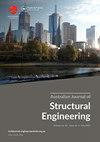1200级钢圆形空心受压构件:试验与设计
IF 1.3
Q4 ENGINEERING, CIVIL
Australian Journal of Structural Engineering
Pub Date : 2021-01-02
DOI:10.1080/13287982.2021.1889089
引用次数: 1
摘要
钢的技术和制造的最新发展导致了这种材料的强度显著增加,同时保持重量不变。这导致高强度钢材料在结构实践中的应用增加,因此对更新设计指南的需求不断增加。本文对标称屈服强度为1250mpa的超高强度钢空心圆构件进行了压缩试验和设计。将其性能与另外两种等级的钢进行比较:300级低碳钢和750级高强度钢。利用有限元软件对不同的截面几何形状进行建模,并根据实验压缩测试进行验证。对一系列截面几何形状和长度进行了参数化分析,并将结果与AS4100和AISC360的现行设计准则进行了比较。同时考虑了截面长细比和构件长细比,对其抗压性能进行了研究。结果表明:随着截面构件长细比和屈服强度的增大,标准预测对截面抗压能力的预测更为保守;根据构件长细限值和压缩能力系数的修改建议,对1200级钢提出了设计建议本文章由计算机程序翻译,如有差异,请以英文原文为准。
Circular hollow compression members of grade 1200 steel: experiments and design
ABSTRACT Recent developments in technology and manufacturing of steel has led to a significant increase in the strength of this material while keeping the weight constant. This has resulted in an increase in the application of high strength steel material in structural practice and consequently a rising demand in updated design guidelines. The present research covers compression experiments and design of ultra-high strength steel hollow circular members with a nominal yield strength of 1250 MPa. The performance is compared against two other grades of steel: Mild Steel grade 300 and high strength steel grade 750. Different section geometries are modelled using finite element software and validated against the experimental compression tests. A parametric analysis is conducted on a range of section geometries and lengths and the result are compared against current design guidelines of AS4100, and AISC360. The compressive performance is studied considering both the section slenderness and the member slenderness ratios. The results show that as the member slenderness and yield strength of the sections increase, the standard predictions give a more conservative prediction of the compression capacity. Using proposed modifications for member slenderness limits and compression capacity factors, design recommendations are suggested for grade 1200 steel
求助全文
通过发布文献求助,成功后即可免费获取论文全文。
去求助
来源期刊

Australian Journal of Structural Engineering
ENGINEERING, CIVIL-
CiteScore
2.50
自引率
0.00%
发文量
31
期刊介绍:
The Australian Journal of Structural Engineering (AJSE) is published under the auspices of the Structural College Board of Engineers Australia. It fulfils part of the Board''s mission for Continuing Professional Development. The journal also offers a means for exchange and interaction of scientific and professional issues and technical developments. The journal is open to members and non-members of Engineers Australia. Original papers on research and development (Technical Papers) and professional matters and achievements (Professional Papers) in all areas relevant to the science, art and practice of structural engineering are considered for possible publication. All papers and technical notes are peer-reviewed. The fundamental criterion for acceptance for publication is the intellectual and professional value of the contribution. Occasionally, papers previously published in essentially the same form elsewhere may be considered for publication. In this case acknowledgement to prior publication must be included in a footnote on page one of the manuscript. These papers are peer-reviewed as new submissions. The length of acceptable contributions typically should not exceed 4,000 to 5,000 word equivalents. Longer manuscripts may be considered at the discretion of the Editor. Technical Notes typically should not exceed about 1,000 word equivalents. Discussions on a Paper or Note published in the AJSE are welcomed. Discussions must address significant matters related to the content of a Paper or Technical Note and may include supplementary and critical comments and questions regarding content.
 求助内容:
求助内容: 应助结果提醒方式:
应助结果提醒方式:


